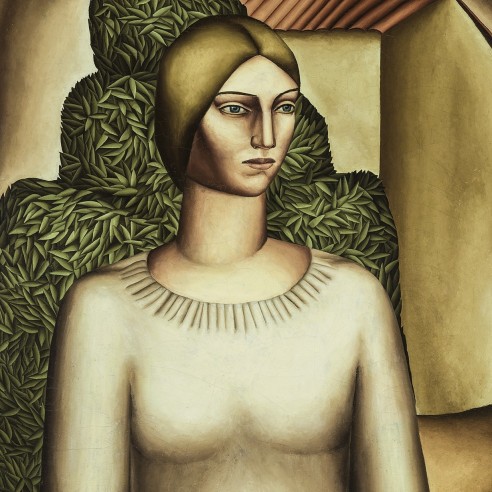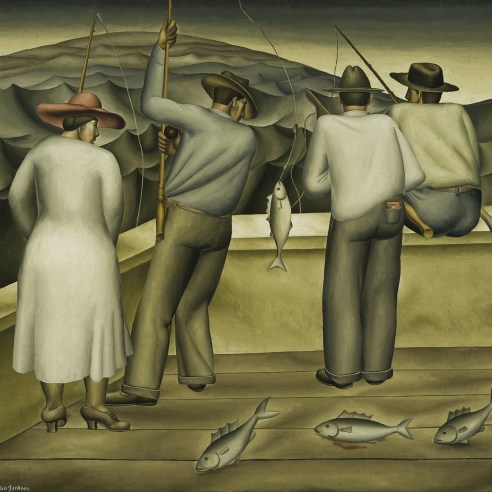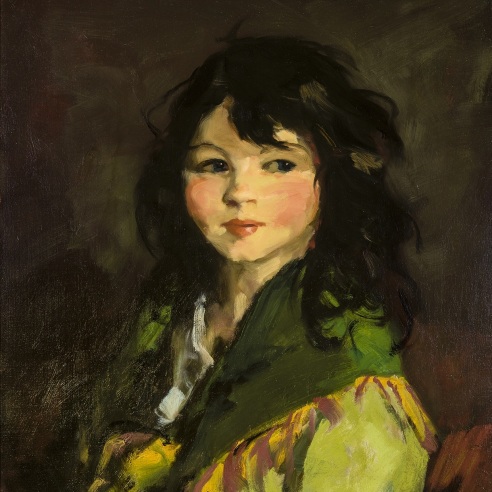
For more than half a century Everett Gee Jackson and his wife, Eileen Dwyer Jackson, occupied a place at the very center of cultural life in San Diego, California. From 1930, until he retired as Professor Emeritus in 1963, Jackson served on the faculty of San Diego State College in California (now San Diego State University), chairing the art faculty and teaching painting and pre-Columbian art. A member of the Contemporary Artists of San Diego as well as a founder of the San Diego Museum, in 1937, he also began a career as an illustrator, adding a substantial income source to an already comfortable life. Trained as a journalist, Eileen Jackson, presided for many years over San Diego society in her role as society editor of the San Diego Union.
Jackson was, however, more than a beloved teacher and pillar of his community. He was, in fact, an exceptional painter whose work served as the first major conduit for the introduction of Mexican modernism into American art. It is a common irony that financial security often works to the detriment of artistic reputation. Such has been the case with Jackson, a regional celebrity who remains little known outside San Diego and perhaps his native Texas. Jackson’s art rarely comes on the art market. The bulk of it is still held by patrons in the San Diego area and by the artist’s Texas and California families. Over a long career, Jackson produced images in a modern idiom that was accessible, but never sentimental.
In October 1927, Eileen Jackson published an article on “The Mexican Movement” in the journal Creative Art. Writing (for obvious reasons) under her maiden name, Eileen Dwyer, she reviewed the work of Diego Rivera, José Clemente Orozco, and David Siquieros, among others, and then described Everett Jackson as “the most interesting of the American group” resident in Mexico. She went on to say that “the mass, not the line plane, interests him. Before other elements his work has this ‘weight dimension.’” When Everett Jackson first began exhibiting his work, in 1927 and ’28, it was greeted warmly by reviewers who nonetheless felt compelled to warn their art-loving audience that this artist was an “ultra-modernist.” Jackson did not recoil, but happily embraced the label. In 1930, he published his own brief manifesto, “Modernism Without Apologies:”
The beauty of modern art has to do greatly with logical structure.... Form is the material of modernism, primarily and it is with that [the artist] builds.... Each object or shape in [the] picture must be related structurally to every other shape and there must be nothing superfluous (The Modern Clubwoman [September 1930), p. 5).
While Jackson’s meticulous understanding of the harmonies of form and color that create beauty in the eye of the beholder was unerring, it did not lead him to abstraction. The enduring quality of Jackson’s work lies in the creative synergy of technique with engaging subject matter. Jackson’s work offers a window into his East Texas boyhood, the excitement of post-revolutionary Mexico, and the promise of the American West Coast as he lived it in San Diego.
Everett Jackson was born in Mexia, Texas. His great-grandfather, Frederick Stith Jackson (1809–1863), a Virginia planter, moved south and west, eventually arriving in 1854 in Anderson County in northeast Texas. Finding rich farmland on the banks of the Trinity River, Jackson established his plantation, growing corn and cotton on 1200 acres worked by 120 slaves. Numerous descendants remain in the area today where the family still owns more than three hundred acres of property. The artist was the next to youngest of seven children of Fanny Eubank and Walter Benjamin Jackson (1858–1932), a grandson of Frederick Jackson. Everett’s father farmed and ran a local cotton gin. Jackson relates anecdotes of his happy East Texas childhood in Goat Tails and Doodlebugs. He was a country boy surrounded by a large and extended land-holding family. After high school, he enrolled at Texas A & M, planning to study architecture. A drawing instructor, struck by Jackson’s natural artistic ability, urged him to develop that talent. In 1921, Jackson went to the Art Institute of Chicago, where he learned to paint in the academically ascendant style there, Impressionism.
Motivated by a stubborn case of strep throat, Jackson left wintry Chicago in December 1922 and returned to Texas. In his absence, Mexia had transformed from a sleepy farm community of about 3,500 people to an oil boom town, with 35,000 people and a stint of martial law. Jackson looked elsewhere. An advertisement for The San Diego Academy of Art caught his eye and he decided to combine art instruction with California sunshine. On a casual blind date, he met a local girl, 17-year-old Eileen Dwyer (1906–1996). Smitten, the two began a romance by correspondence. They would eventually marry in 1926. Still footloose in 1923, Jackson returned to Texas, where he had arranged to meet a fellow art student from Chicago, Lowell D. Houser (1902–1971) to travel to the Sabinas Mountains in Mexico, just across the Texas-Mexico border. Jackson’s first trip to Mexico, though brief, was decisive.
Jackson and Houser returned to Mexico later in 1923 and remained there until 1927, punctuated, for Jackson, by two trips home, in 1925 and 1926, to woo and then marry Eileen Dwyer. The two young American artists, Jackson and Houser, moved around, always seeking small, remote, scenic, authentic and hopefully undiscovered painting locales. They rented houses in Chapala and Ajijic, both small villages on the shore of Lake Chapala in the State of Jalisco in central Mexico, and in Guanajuato in adjacent Guanajuato State. At Houser’s urging, they also stopped briefly in Mexico City for a quick look at the already renowned murals in public buildings there.
In November 1926, Everett and Eileen Jackson left Chapala for Coyoacán, then a small historic suburb, now a part of Mexico City. While Jackson was in Texas, marrying Eileen, Houser had met Anita Brenner (1905–1974) who offered him work as an archeology expedition artist. Born in Mexico to Latvian Jewish immigrants, and educated in San Antonio, Texas, Brenner was the cultural fulcrum of an international community of young artists and intellectuals based in Mexico City. A journalist and art critic, Brenner became a good friend of the Jacksons and stayed with them during her convalescence from an appendectomy. Brenner’s presence attracted a steady stream of visitors to the Jackson household, including the artists Jean Charlot (1898–1979), and José Clemente Orozco. Charlot in particular, exerted an enormous influence. Of French and Mexican parentage, he learned true fresco technique in Paris and returned to Mexico where he worked alongside Diego Rivera. Charlot critiqued the work of Jackson and Houser. Jackson revisited the murals and revised his opinion of them; in fact, he embraced them and their style wholeheartedly.
In early spring of 1927, at Brenner’s urging, the Jacksons left Cocoacán for Tehuantepec, an ancient capital of the Zapotec Indians on the Tehuantepec Isthmus on the Pacific coast of southern Mexico. Two weeks after they arrived Jackson fell ill with what was later diagnosed as malaria. Eileen quickly organized a trip home to Texas. The year that Jackson spent recovering in Texas proved a period of energetic painting. Concentrating on Texas and Mexican subjects. Jackson also actively engaged in career building, sending his work to competitions and exhibitions. In 1928, the Jacksons moved to San Diego, where their daughter, Jerry Gee Jackson was born. Though Jackson was offered a faculty position in Texas, he and Eileen chose to remain in San Diego, a decision whose wisdom was confirmed in 1930 when Jackson accepted an appointment at San Diego State College. The course of his life was set. After he took up his teaching position in San Diego, Jackson appears to have given up the pursuit of a national reputation.



